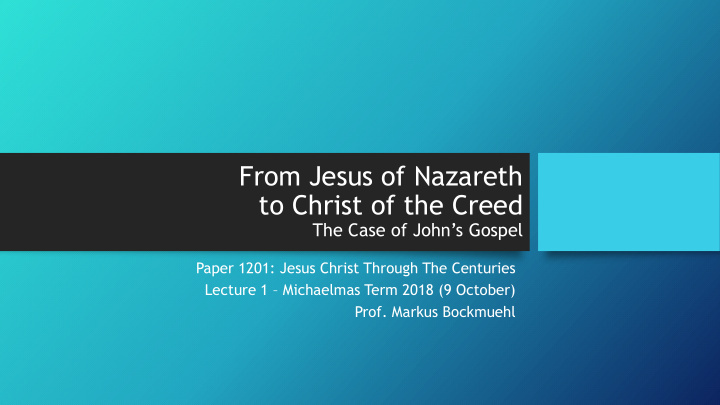



From Jesus of Nazareth to Christ of the Creed The Case of John’s Gospel Paper 1201: Jesus Christ Through The Centuries Lecture 1 – Michaelmas Term 2018 (9 October) Prof. Markus Bockmuehl
Introduction 1. Jesus in relation to over half the world’s population: 2.5 billion Christians, 1.8 billion Muslims, etc. 2. From Jesus of Nazareth to the Christian creeds 3. The Gospel of John and the Letter to the Hebrews 4. Clement of Alexandria (c. 200): “But, last of all, John … composed a spiritual Gospel ”
John’s Prologue (1.1 -18) • 1:1 In the beginning was the Word , and the Word was with God, and the Word was God . … 1:14 And the Word became flesh and lived among us, and we have seen his glory, the glory as of a father’s only son, full of grace and truth. … 1:16 From his fullness we have all received, grace upon grace. 1:17 The law indeed was given through Moses; grace and truth came through Jesus Christ. 1:18 No one has ever seen God. It is God the only Son , who is close to the Father’s heart, who has made him known.
John’s (first) Epilogue (20.30 -31) • 20:30 Now Jesus did many other signs in the presence of his disciples, which are not written in this book. 20:31 But these are written so that you may come to believe that Jesus is the Messiah, the Son of God , and that through believing you may have life in his name .
The Gospel of Seeing the Word • 1.14 ‘we have seen his glory’ • 1.46; 4.29 ‘come and see’ • 9.25 ‘though I was blind, now I see’. Cf 9.39 • 12.45 ‘whoever sees me sees him who sent me’
Three Ways of Seeing Jesus 1.Jesus of Nazareth and the fragments of history 2. The narrative Jesus: ‘earthly’, ‘historical’ 3.The theological Jesus as the historical Christ
The crucifixion of Yehohanan ben-Hagkol, Giv‘at ha-Mivtar, Jerusalem
Antonio Ciseri (1821-1891) Ecce Homo (“This is the Man”)
Matthias Grünewald (c. 1475-1428): Crucifixion (Isenheim Altar)
Jesus Christ in the Gospel of John 1.Christology as the Central Theme 2. Jesus as the “Word” (Logos) 3.Descent and Ascent
John’s Logos and the Christian Creed • We believe in one Lord, Jesus Christ, the only Son of God , eternally begotten of the Father , God from God, Light from Light , true God from true God, begotten, not made, of one Being with the Father ; through him all things were made . • For us and for our salvation he came down from heaven , was incarnate from the Holy Spirit and the Virgin Mary and was made man . For our sake he was crucified under Pontius Pilate; he suffered death and was buried. On the third day he rose again in accordance with the Scriptures; he ascended into heaven and is seated at the right hand of the Father. • He will come again in glory to judge the living and the dead, and his kingdom will have no end.
Jesus Christ as the Son of God • “Son of Man” as “Son of God” in John’s Gospel • “The Son” and “The Only Son” • Sending, Descending, Ascending • “I Am” Sayings • Cross and Atonement? • Jesus, God and Believers • The Continued Presence of the Spirit – Advocate (“Paraclete”) • Conclusion
A Few Books • Bauckham, Richard J. 2005. "Monotheism and Christology in the Gospel of John." In Contours of Christology in the New Testament , 148-66. Ed. R. N. Longenecker. Grand Rapids: Eerdmans. • Belle, Gilbert van et al , eds. . 2005. Theology and Christology in the Fourth Gospel. Leuven: Leuven University Press/Peeters • Bockmuehl, Markus. 2018. "The Gospels on the Knowledge of God." In A Transforming Vision, 57-70. Ed. G. Westhaver. London: SCM Press. • Loader, William R. G. 2017. Jesus in John's Gospel: Structure and Issues in Johannine Christology . Grand Rapids: Eerdmans. • Macaskill, Grant. 2018 (forthcoming). ‘Name Christology, Divine Aseity and the I Am Sayings in the Fourth Gospel.’ Journal of Theological Interpretation 12. • Morgan, Robert. 1996. "Can the Critical Study of Scripture Provide a Doctrinal Norm?" Journal of Religion 76: 206-32. • Tam, Josaphat C. 2015. Apprehension of Jesus in the Gospel of John . Tübingen: Mohr Siebeck. • Yeago, David S. 1994. "The New Testament and the Nicene Dogma: A Contribution to the Recovery of Theological Exegesis." Pro Ecclesia 3: 152-64.
Recommend
More recommend